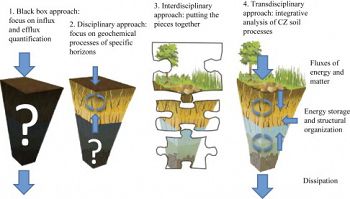Perdrial et al., 2015
Chapter 6 – Soil Geochemistry in the Critical Zone: Influence on Atmosphere, Surface- and Groundwater Composition
Perdrial J., Thompson A., Chorover J. (2015)
Developments in Earth Surface Processes 19: 173–201 Cross-CZO
-
Catalina-Jemez, Luquillo, Reynolds, INVESTIGATOR
-
Calhoun, Luquillo, INVESTIGATOR, COLLABORATOR
-
Catalina-Jemez, INVESTIGATOR
Abstract
Different approaches used to study soil geochemical processes. The goal of integrative analysis of CZ processes is to combine all previous approaches in a synergistic effort.
In this chapter we introduce soil biogeochemical processes that have broad influence on Critical Zone function. Soil comprises all unconsolidated material above competent bedrock that is open to – and structured by – fluxes of energy and matter. These fluxes drive biotic and abiotic reactions that result from the open system disequilibria. While (bio)geochemical reactions occur at the molecular scale, they have implications for ecosystem function and human sustainability. Many of the characteristic changes of the Anthropocene – including climatic and land use changes – have direct influence on soil biogeochemistry with cascading effects on the capacity of the Critical Zone to sustain human life. Here we highlight several of these “scalable” soil biogeochemical reactions, give examples on how they are impacted by external forcings, and show how they “reach” beyond the extent of soils to impact atmosphere, surface- and groundwater composition.
Citation
Perdrial J., Thompson A., Chorover J. (2015): Chapter 6 – Soil Geochemistry in the Critical Zone: Influence on Atmosphere, Surface- and Groundwater Composition. Developments in Earth Surface Processes 19: 173–201. DOI: 10.1016/B978-0-444-63369-9.00006-9
 This Paper/Book acknowledges NSF CZO grant support.
This Paper/Book acknowledges NSF CZO grant support.
Explore Further




